Taxation Law: Comprehensive Analysis of Bruce Lee's Income Tax, TAX305
VerifiedAdded on 2023/06/07
|10
|2559
|364
Case Study
AI Summary
This case study provides a comprehensive analysis of Bruce Lee's income tax situation for the year ended 30 June 2018. It identifies and assesses various sources of assessable income, including professional legal fees, salary from part-time lecturing, interest income, rental income, and dividend income. The study also examines allowable deductions such as office rent, cleaning contractor payments, employee salary, and expenses related to the investment property, along with specific deductions like tax agent fees and the cost of replacing storm-damaged roof tiles. Ultimately, the study computes Bruce Lee's taxable income, tax liability, Medicare levy, and any applicable surcharges, while also considering carry-forward losses and franking credits, leading to a final determination of the total tax payable for the year. Desklib offers similar solved assignments and past papers for students.
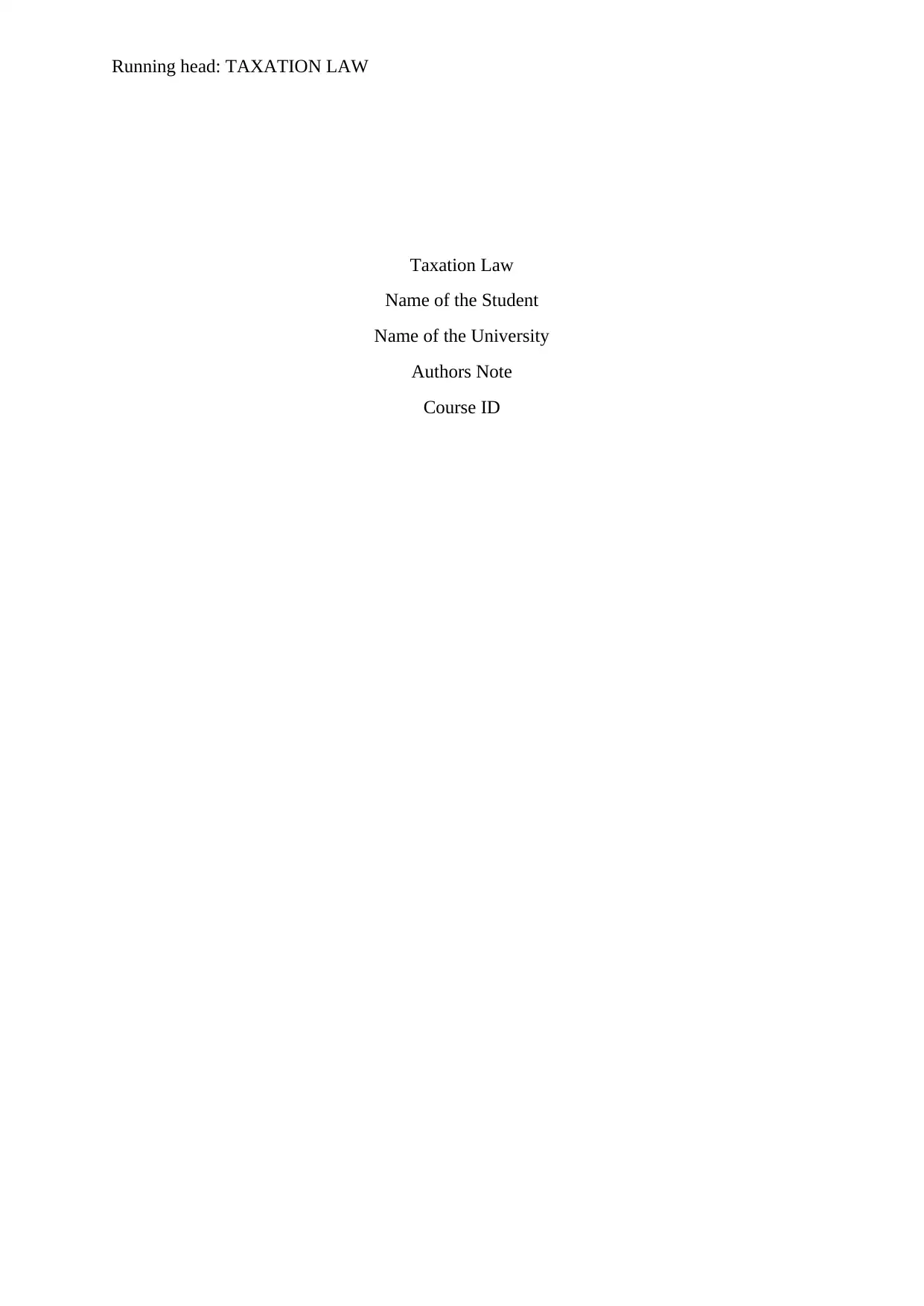
Running head: TAXATION LAW
Taxation Law
Name of the Student
Name of the University
Authors Note
Course ID
Taxation Law
Name of the Student
Name of the University
Authors Note
Course ID
Paraphrase This Document
Need a fresh take? Get an instant paraphrase of this document with our AI Paraphraser
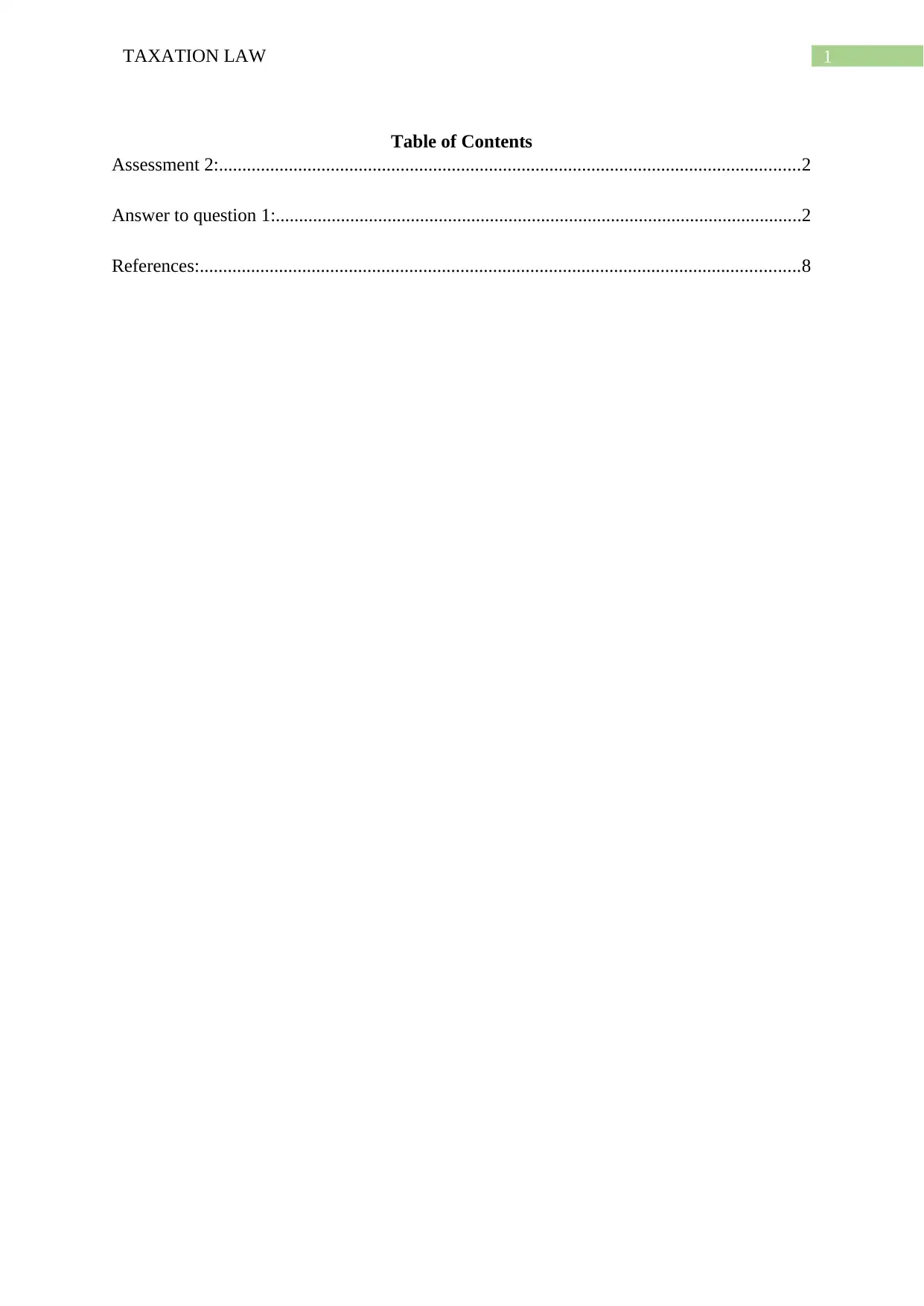
1TAXATION LAW
Table of Contents
Assessment 2:.............................................................................................................................2
Answer to question 1:.................................................................................................................2
References:.................................................................................................................................8
Table of Contents
Assessment 2:.............................................................................................................................2
Answer to question 1:.................................................................................................................2
References:.................................................................................................................................8
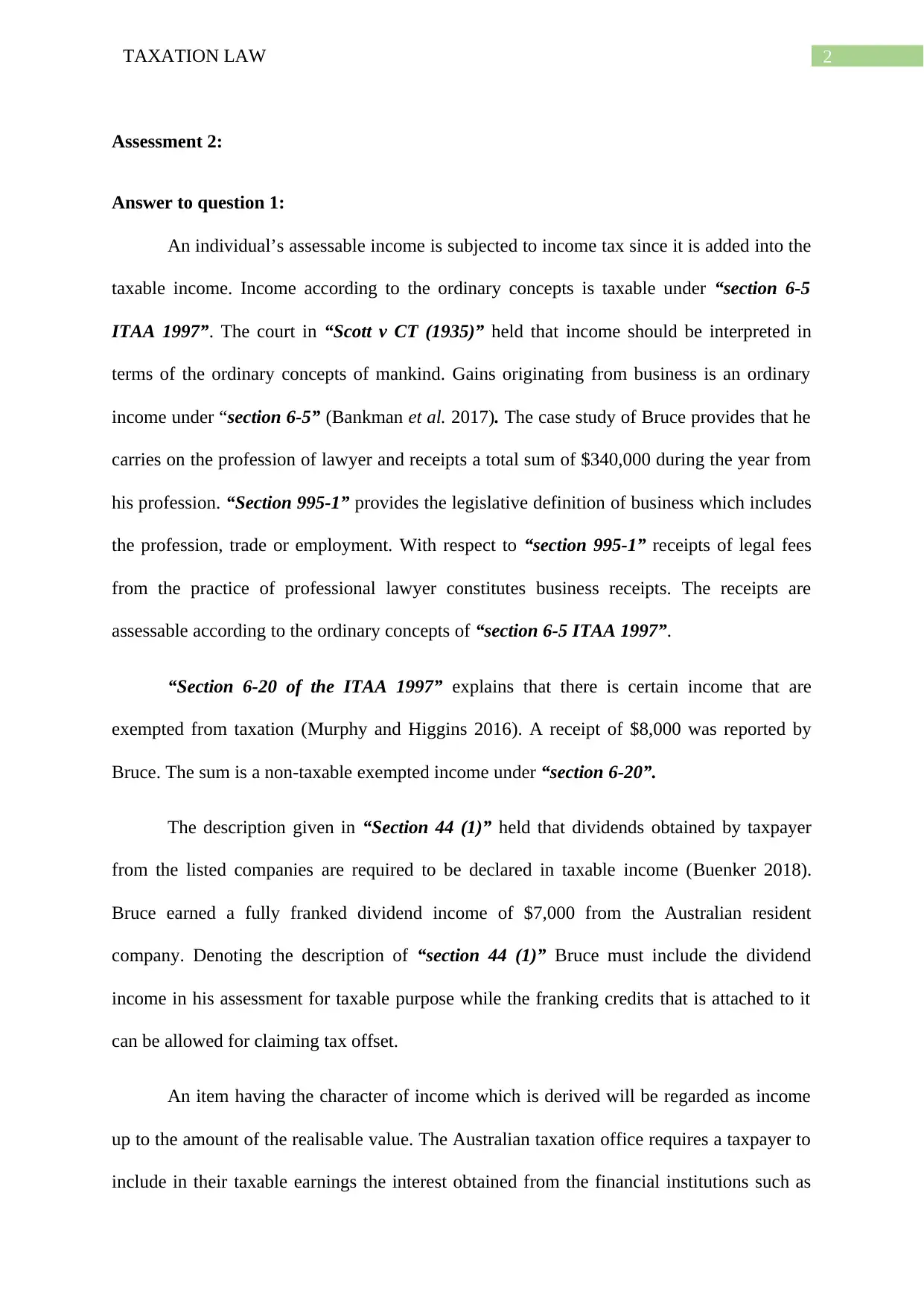
2TAXATION LAW
Assessment 2:
Answer to question 1:
An individual’s assessable income is subjected to income tax since it is added into the
taxable income. Income according to the ordinary concepts is taxable under “section 6-5
ITAA 1997”. The court in “Scott v CT (1935)” held that income should be interpreted in
terms of the ordinary concepts of mankind. Gains originating from business is an ordinary
income under “section 6-5” (Bankman et al. 2017). The case study of Bruce provides that he
carries on the profession of lawyer and receipts a total sum of $340,000 during the year from
his profession. “Section 995-1” provides the legislative definition of business which includes
the profession, trade or employment. With respect to “section 995-1” receipts of legal fees
from the practice of professional lawyer constitutes business receipts. The receipts are
assessable according to the ordinary concepts of “section 6-5 ITAA 1997”.
“Section 6-20 of the ITAA 1997” explains that there is certain income that are
exempted from taxation (Murphy and Higgins 2016). A receipt of $8,000 was reported by
Bruce. The sum is a non-taxable exempted income under “section 6-20”.
The description given in “Section 44 (1)” held that dividends obtained by taxpayer
from the listed companies are required to be declared in taxable income (Buenker 2018).
Bruce earned a fully franked dividend income of $7,000 from the Australian resident
company. Denoting the description of “section 44 (1)” Bruce must include the dividend
income in his assessment for taxable purpose while the franking credits that is attached to it
can be allowed for claiming tax offset.
An item having the character of income which is derived will be regarded as income
up to the amount of the realisable value. The Australian taxation office requires a taxpayer to
include in their taxable earnings the interest obtained from the financial institutions such as
Assessment 2:
Answer to question 1:
An individual’s assessable income is subjected to income tax since it is added into the
taxable income. Income according to the ordinary concepts is taxable under “section 6-5
ITAA 1997”. The court in “Scott v CT (1935)” held that income should be interpreted in
terms of the ordinary concepts of mankind. Gains originating from business is an ordinary
income under “section 6-5” (Bankman et al. 2017). The case study of Bruce provides that he
carries on the profession of lawyer and receipts a total sum of $340,000 during the year from
his profession. “Section 995-1” provides the legislative definition of business which includes
the profession, trade or employment. With respect to “section 995-1” receipts of legal fees
from the practice of professional lawyer constitutes business receipts. The receipts are
assessable according to the ordinary concepts of “section 6-5 ITAA 1997”.
“Section 6-20 of the ITAA 1997” explains that there is certain income that are
exempted from taxation (Murphy and Higgins 2016). A receipt of $8,000 was reported by
Bruce. The sum is a non-taxable exempted income under “section 6-20”.
The description given in “Section 44 (1)” held that dividends obtained by taxpayer
from the listed companies are required to be declared in taxable income (Buenker 2018).
Bruce earned a fully franked dividend income of $7,000 from the Australian resident
company. Denoting the description of “section 44 (1)” Bruce must include the dividend
income in his assessment for taxable purpose while the franking credits that is attached to it
can be allowed for claiming tax offset.
An item having the character of income which is derived will be regarded as income
up to the amount of the realisable value. The Australian taxation office requires a taxpayer to
include in their taxable earnings the interest obtained from the financial institutions such as
⊘ This is a preview!⊘
Do you want full access?
Subscribe today to unlock all pages.

Trusted by 1+ million students worldwide
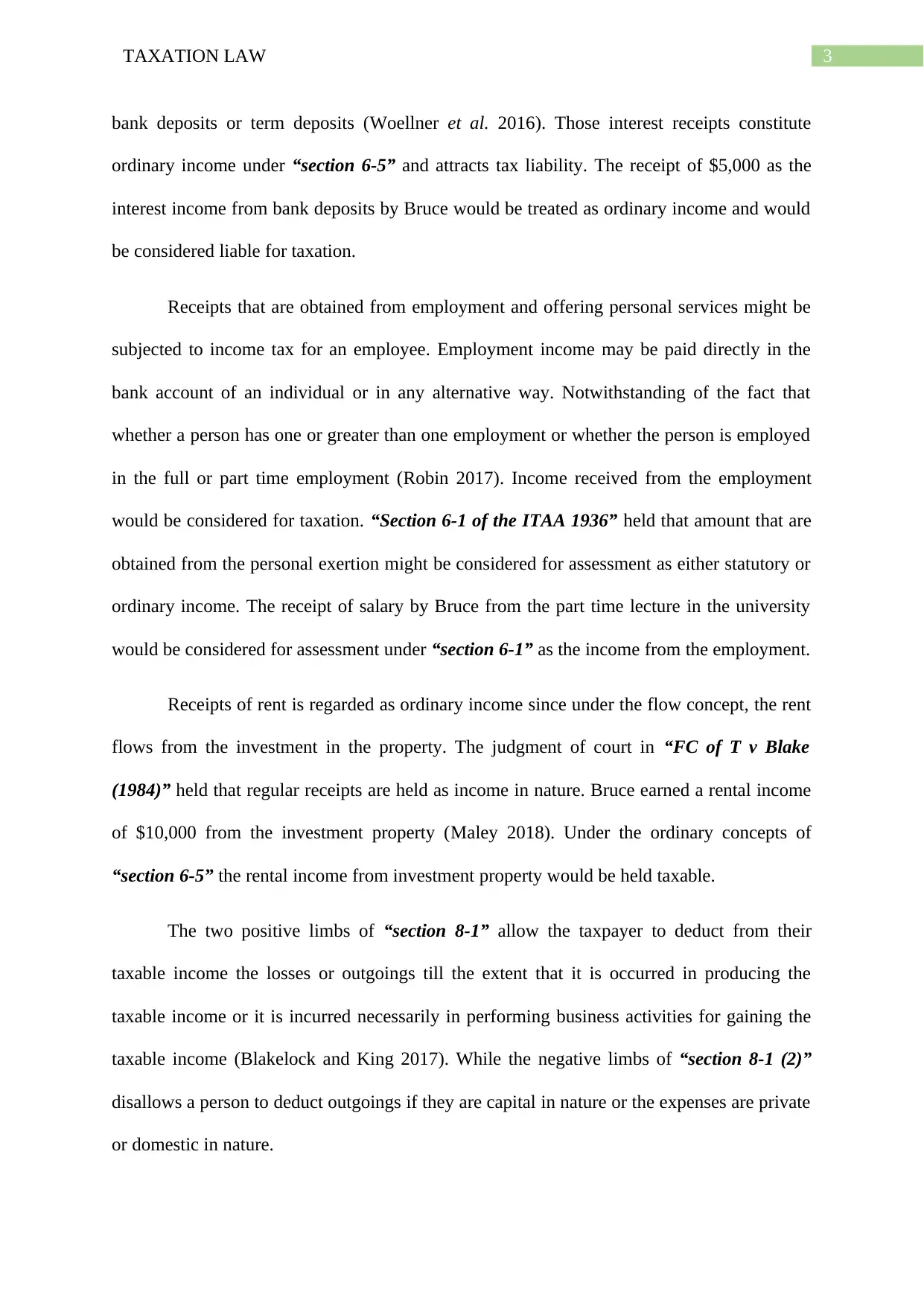
3TAXATION LAW
bank deposits or term deposits (Woellner et al. 2016). Those interest receipts constitute
ordinary income under “section 6-5” and attracts tax liability. The receipt of $5,000 as the
interest income from bank deposits by Bruce would be treated as ordinary income and would
be considered liable for taxation.
Receipts that are obtained from employment and offering personal services might be
subjected to income tax for an employee. Employment income may be paid directly in the
bank account of an individual or in any alternative way. Notwithstanding of the fact that
whether a person has one or greater than one employment or whether the person is employed
in the full or part time employment (Robin 2017). Income received from the employment
would be considered for taxation. “Section 6-1 of the ITAA 1936” held that amount that are
obtained from the personal exertion might be considered for assessment as either statutory or
ordinary income. The receipt of salary by Bruce from the part time lecture in the university
would be considered for assessment under “section 6-1” as the income from the employment.
Receipts of rent is regarded as ordinary income since under the flow concept, the rent
flows from the investment in the property. The judgment of court in “FC of T v Blake
(1984)” held that regular receipts are held as income in nature. Bruce earned a rental income
of $10,000 from the investment property (Maley 2018). Under the ordinary concepts of
“section 6-5” the rental income from investment property would be held taxable.
The two positive limbs of “section 8-1” allow the taxpayer to deduct from their
taxable income the losses or outgoings till the extent that it is occurred in producing the
taxable income or it is incurred necessarily in performing business activities for gaining the
taxable income (Blakelock and King 2017). While the negative limbs of “section 8-1 (2)”
disallows a person to deduct outgoings if they are capital in nature or the expenses are private
or domestic in nature.
bank deposits or term deposits (Woellner et al. 2016). Those interest receipts constitute
ordinary income under “section 6-5” and attracts tax liability. The receipt of $5,000 as the
interest income from bank deposits by Bruce would be treated as ordinary income and would
be considered liable for taxation.
Receipts that are obtained from employment and offering personal services might be
subjected to income tax for an employee. Employment income may be paid directly in the
bank account of an individual or in any alternative way. Notwithstanding of the fact that
whether a person has one or greater than one employment or whether the person is employed
in the full or part time employment (Robin 2017). Income received from the employment
would be considered for taxation. “Section 6-1 of the ITAA 1936” held that amount that are
obtained from the personal exertion might be considered for assessment as either statutory or
ordinary income. The receipt of salary by Bruce from the part time lecture in the university
would be considered for assessment under “section 6-1” as the income from the employment.
Receipts of rent is regarded as ordinary income since under the flow concept, the rent
flows from the investment in the property. The judgment of court in “FC of T v Blake
(1984)” held that regular receipts are held as income in nature. Bruce earned a rental income
of $10,000 from the investment property (Maley 2018). Under the ordinary concepts of
“section 6-5” the rental income from investment property would be held taxable.
The two positive limbs of “section 8-1” allow the taxpayer to deduct from their
taxable income the losses or outgoings till the extent that it is occurred in producing the
taxable income or it is incurred necessarily in performing business activities for gaining the
taxable income (Blakelock and King 2017). While the negative limbs of “section 8-1 (2)”
disallows a person to deduct outgoings if they are capital in nature or the expenses are private
or domestic in nature.
Paraphrase This Document
Need a fresh take? Get an instant paraphrase of this document with our AI Paraphraser
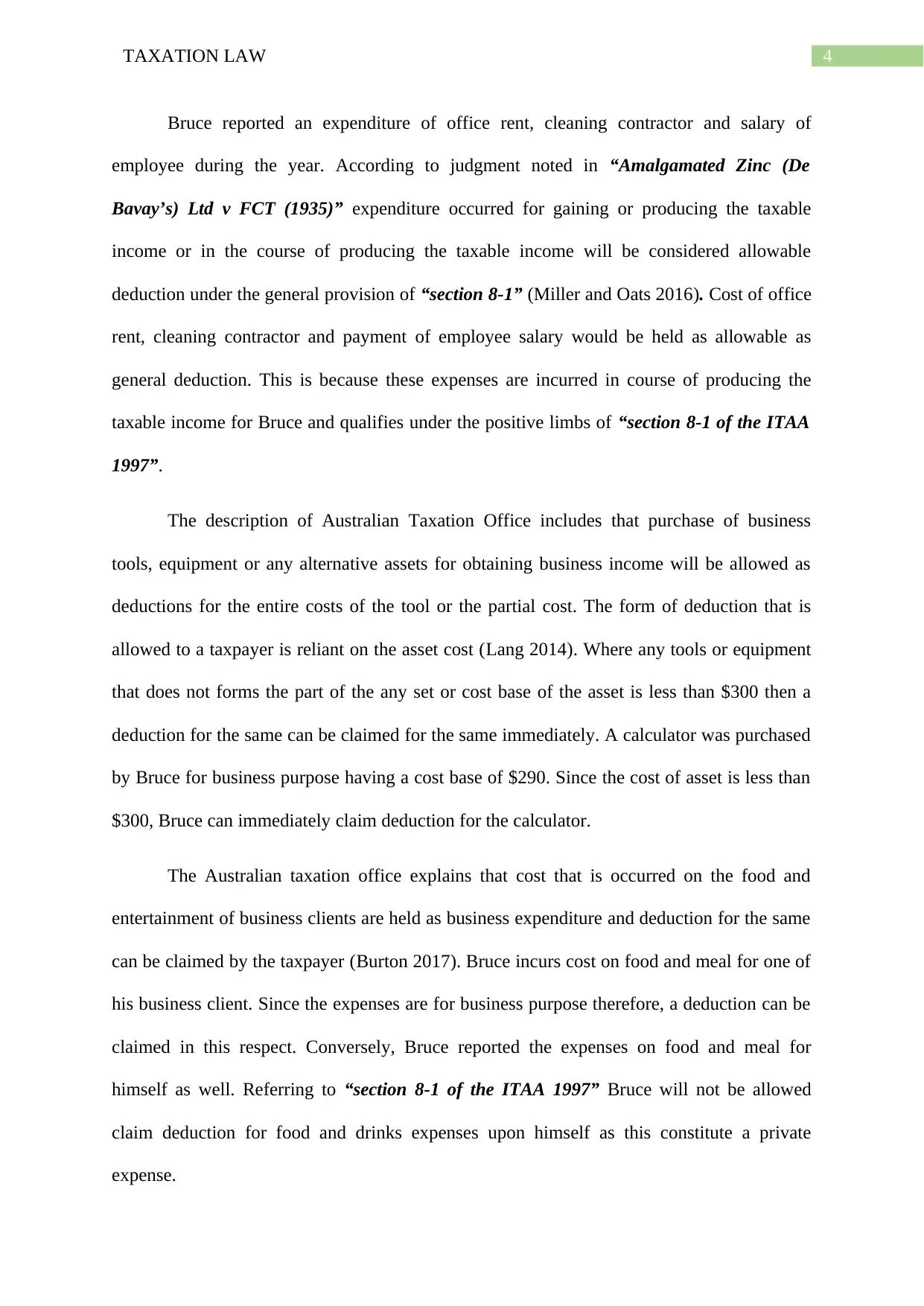
4TAXATION LAW
Bruce reported an expenditure of office rent, cleaning contractor and salary of
employee during the year. According to judgment noted in “Amalgamated Zinc (De
Bavay’s) Ltd v FCT (1935)” expenditure occurred for gaining or producing the taxable
income or in the course of producing the taxable income will be considered allowable
deduction under the general provision of “section 8-1” (Miller and Oats 2016). Cost of office
rent, cleaning contractor and payment of employee salary would be held as allowable as
general deduction. This is because these expenses are incurred in course of producing the
taxable income for Bruce and qualifies under the positive limbs of “section 8-1 of the ITAA
1997”.
The description of Australian Taxation Office includes that purchase of business
tools, equipment or any alternative assets for obtaining business income will be allowed as
deductions for the entire costs of the tool or the partial cost. The form of deduction that is
allowed to a taxpayer is reliant on the asset cost (Lang 2014). Where any tools or equipment
that does not forms the part of the any set or cost base of the asset is less than $300 then a
deduction for the same can be claimed for the same immediately. A calculator was purchased
by Bruce for business purpose having a cost base of $290. Since the cost of asset is less than
$300, Bruce can immediately claim deduction for the calculator.
The Australian taxation office explains that cost that is occurred on the food and
entertainment of business clients are held as business expenditure and deduction for the same
can be claimed by the taxpayer (Burton 2017). Bruce incurs cost on food and meal for one of
his business client. Since the expenses are for business purpose therefore, a deduction can be
claimed in this respect. Conversely, Bruce reported the expenses on food and meal for
himself as well. Referring to “section 8-1 of the ITAA 1997” Bruce will not be allowed
claim deduction for food and drinks expenses upon himself as this constitute a private
expense.
Bruce reported an expenditure of office rent, cleaning contractor and salary of
employee during the year. According to judgment noted in “Amalgamated Zinc (De
Bavay’s) Ltd v FCT (1935)” expenditure occurred for gaining or producing the taxable
income or in the course of producing the taxable income will be considered allowable
deduction under the general provision of “section 8-1” (Miller and Oats 2016). Cost of office
rent, cleaning contractor and payment of employee salary would be held as allowable as
general deduction. This is because these expenses are incurred in course of producing the
taxable income for Bruce and qualifies under the positive limbs of “section 8-1 of the ITAA
1997”.
The description of Australian Taxation Office includes that purchase of business
tools, equipment or any alternative assets for obtaining business income will be allowed as
deductions for the entire costs of the tool or the partial cost. The form of deduction that is
allowed to a taxpayer is reliant on the asset cost (Lang 2014). Where any tools or equipment
that does not forms the part of the any set or cost base of the asset is less than $300 then a
deduction for the same can be claimed for the same immediately. A calculator was purchased
by Bruce for business purpose having a cost base of $290. Since the cost of asset is less than
$300, Bruce can immediately claim deduction for the calculator.
The Australian taxation office explains that cost that is occurred on the food and
entertainment of business clients are held as business expenditure and deduction for the same
can be claimed by the taxpayer (Burton 2017). Bruce incurs cost on food and meal for one of
his business client. Since the expenses are for business purpose therefore, a deduction can be
claimed in this respect. Conversely, Bruce reported the expenses on food and meal for
himself as well. Referring to “section 8-1 of the ITAA 1997” Bruce will not be allowed
claim deduction for food and drinks expenses upon himself as this constitute a private
expense.
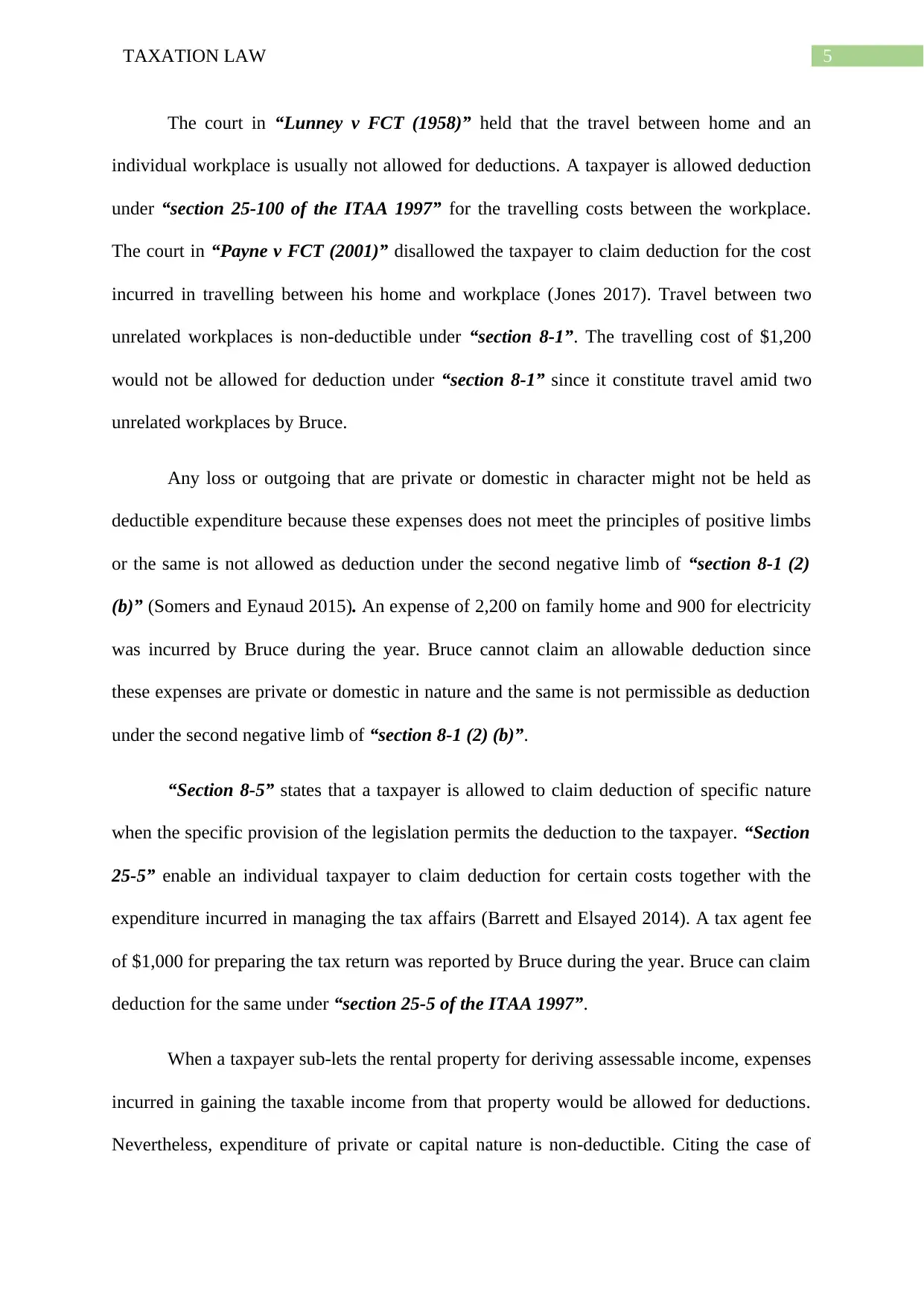
5TAXATION LAW
The court in “Lunney v FCT (1958)” held that the travel between home and an
individual workplace is usually not allowed for deductions. A taxpayer is allowed deduction
under “section 25-100 of the ITAA 1997” for the travelling costs between the workplace.
The court in “Payne v FCT (2001)” disallowed the taxpayer to claim deduction for the cost
incurred in travelling between his home and workplace (Jones 2017). Travel between two
unrelated workplaces is non-deductible under “section 8-1”. The travelling cost of $1,200
would not be allowed for deduction under “section 8-1” since it constitute travel amid two
unrelated workplaces by Bruce.
Any loss or outgoing that are private or domestic in character might not be held as
deductible expenditure because these expenses does not meet the principles of positive limbs
or the same is not allowed as deduction under the second negative limb of “section 8-1 (2)
(b)” (Somers and Eynaud 2015). An expense of 2,200 on family home and 900 for electricity
was incurred by Bruce during the year. Bruce cannot claim an allowable deduction since
these expenses are private or domestic in nature and the same is not permissible as deduction
under the second negative limb of “section 8-1 (2) (b)”.
“Section 8-5” states that a taxpayer is allowed to claim deduction of specific nature
when the specific provision of the legislation permits the deduction to the taxpayer. “Section
25-5” enable an individual taxpayer to claim deduction for certain costs together with the
expenditure incurred in managing the tax affairs (Barrett and Elsayed 2014). A tax agent fee
of $1,000 for preparing the tax return was reported by Bruce during the year. Bruce can claim
deduction for the same under “section 25-5 of the ITAA 1997”.
When a taxpayer sub-lets the rental property for deriving assessable income, expenses
incurred in gaining the taxable income from that property would be allowed for deductions.
Nevertheless, expenditure of private or capital nature is non-deductible. Citing the case of
The court in “Lunney v FCT (1958)” held that the travel between home and an
individual workplace is usually not allowed for deductions. A taxpayer is allowed deduction
under “section 25-100 of the ITAA 1997” for the travelling costs between the workplace.
The court in “Payne v FCT (2001)” disallowed the taxpayer to claim deduction for the cost
incurred in travelling between his home and workplace (Jones 2017). Travel between two
unrelated workplaces is non-deductible under “section 8-1”. The travelling cost of $1,200
would not be allowed for deduction under “section 8-1” since it constitute travel amid two
unrelated workplaces by Bruce.
Any loss or outgoing that are private or domestic in character might not be held as
deductible expenditure because these expenses does not meet the principles of positive limbs
or the same is not allowed as deduction under the second negative limb of “section 8-1 (2)
(b)” (Somers and Eynaud 2015). An expense of 2,200 on family home and 900 for electricity
was incurred by Bruce during the year. Bruce cannot claim an allowable deduction since
these expenses are private or domestic in nature and the same is not permissible as deduction
under the second negative limb of “section 8-1 (2) (b)”.
“Section 8-5” states that a taxpayer is allowed to claim deduction of specific nature
when the specific provision of the legislation permits the deduction to the taxpayer. “Section
25-5” enable an individual taxpayer to claim deduction for certain costs together with the
expenditure incurred in managing the tax affairs (Barrett and Elsayed 2014). A tax agent fee
of $1,000 for preparing the tax return was reported by Bruce during the year. Bruce can claim
deduction for the same under “section 25-5 of the ITAA 1997”.
When a taxpayer sub-lets the rental property for deriving assessable income, expenses
incurred in gaining the taxable income from that property would be allowed for deductions.
Nevertheless, expenditure of private or capital nature is non-deductible. Citing the case of
⊘ This is a preview!⊘
Do you want full access?
Subscribe today to unlock all pages.

Trusted by 1+ million students worldwide
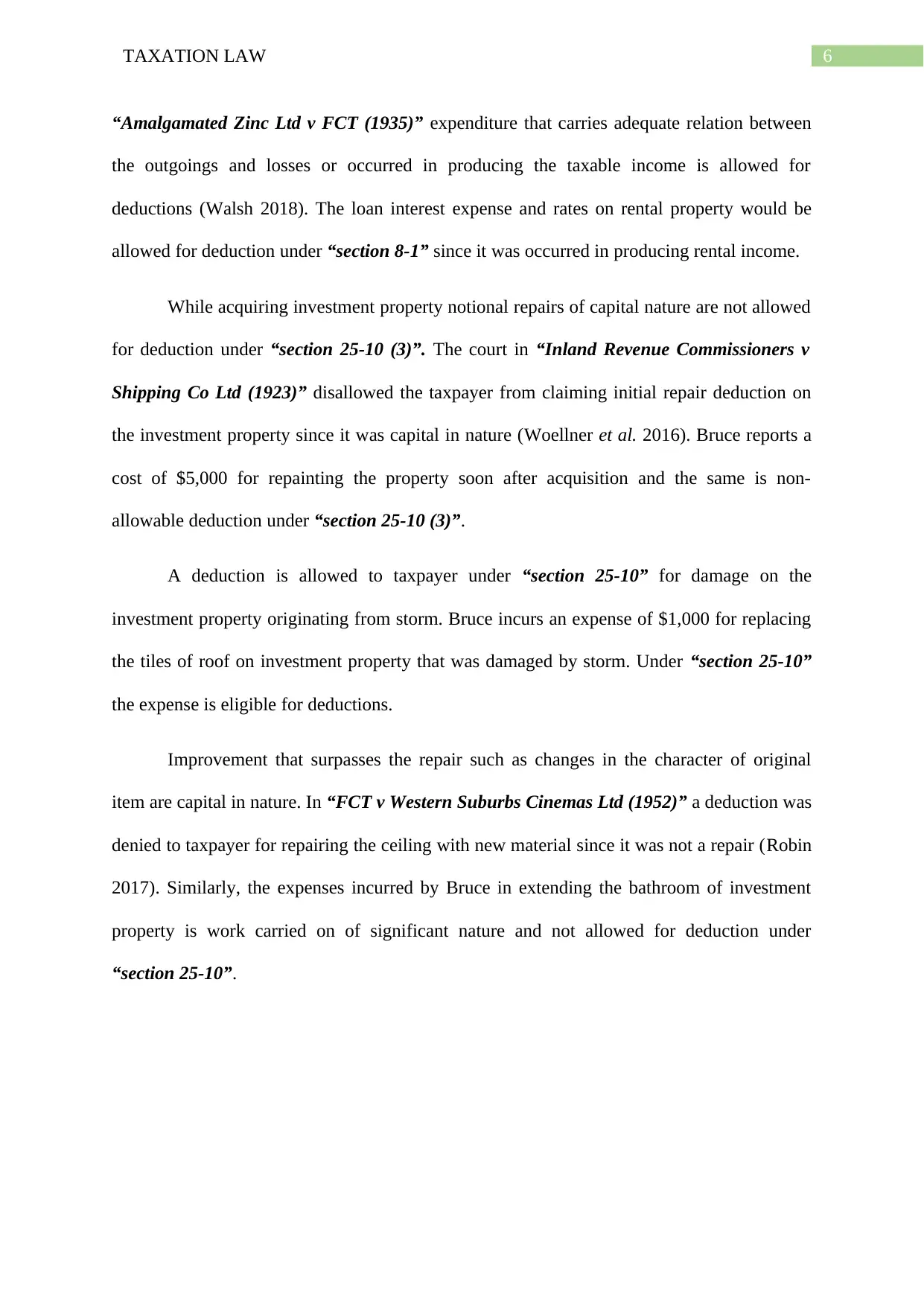
6TAXATION LAW
“Amalgamated Zinc Ltd v FCT (1935)” expenditure that carries adequate relation between
the outgoings and losses or occurred in producing the taxable income is allowed for
deductions (Walsh 2018). The loan interest expense and rates on rental property would be
allowed for deduction under “section 8-1” since it was occurred in producing rental income.
While acquiring investment property notional repairs of capital nature are not allowed
for deduction under “section 25-10 (3)”. The court in “Inland Revenue Commissioners v
Shipping Co Ltd (1923)” disallowed the taxpayer from claiming initial repair deduction on
the investment property since it was capital in nature (Woellner et al. 2016). Bruce reports a
cost of $5,000 for repainting the property soon after acquisition and the same is non-
allowable deduction under “section 25-10 (3)”.
A deduction is allowed to taxpayer under “section 25-10” for damage on the
investment property originating from storm. Bruce incurs an expense of $1,000 for replacing
the tiles of roof on investment property that was damaged by storm. Under “section 25-10”
the expense is eligible for deductions.
Improvement that surpasses the repair such as changes in the character of original
item are capital in nature. In “FCT v Western Suburbs Cinemas Ltd (1952)” a deduction was
denied to taxpayer for repairing the ceiling with new material since it was not a repair (Robin
2017). Similarly, the expenses incurred by Bruce in extending the bathroom of investment
property is work carried on of significant nature and not allowed for deduction under
“section 25-10”.
“Amalgamated Zinc Ltd v FCT (1935)” expenditure that carries adequate relation between
the outgoings and losses or occurred in producing the taxable income is allowed for
deductions (Walsh 2018). The loan interest expense and rates on rental property would be
allowed for deduction under “section 8-1” since it was occurred in producing rental income.
While acquiring investment property notional repairs of capital nature are not allowed
for deduction under “section 25-10 (3)”. The court in “Inland Revenue Commissioners v
Shipping Co Ltd (1923)” disallowed the taxpayer from claiming initial repair deduction on
the investment property since it was capital in nature (Woellner et al. 2016). Bruce reports a
cost of $5,000 for repainting the property soon after acquisition and the same is non-
allowable deduction under “section 25-10 (3)”.
A deduction is allowed to taxpayer under “section 25-10” for damage on the
investment property originating from storm. Bruce incurs an expense of $1,000 for replacing
the tiles of roof on investment property that was damaged by storm. Under “section 25-10”
the expense is eligible for deductions.
Improvement that surpasses the repair such as changes in the character of original
item are capital in nature. In “FCT v Western Suburbs Cinemas Ltd (1952)” a deduction was
denied to taxpayer for repairing the ceiling with new material since it was not a repair (Robin
2017). Similarly, the expenses incurred by Bruce in extending the bathroom of investment
property is work carried on of significant nature and not allowed for deduction under
“section 25-10”.
Paraphrase This Document
Need a fresh take? Get an instant paraphrase of this document with our AI Paraphraser
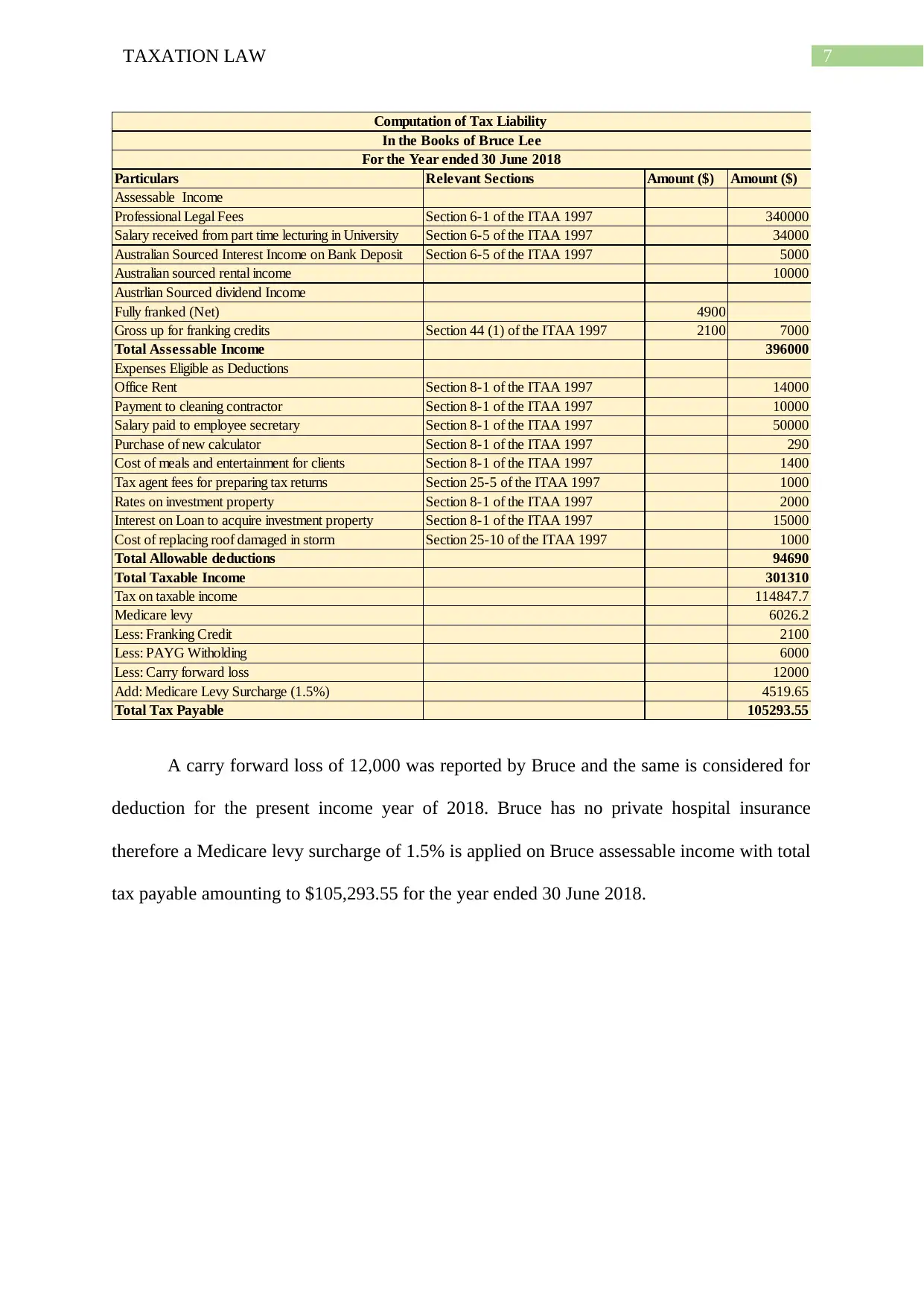
7TAXATION LAW
Particulars Relevant Sections Amount ($) Amount ($)
Assessable Income
Professional Legal Fees Section 6-1 of the ITAA 1997 340000
Salary received from part time lecturing in University Section 6-5 of the ITAA 1997 34000
Australian Sourced Interest Income on Bank Deposit Section 6-5 of the ITAA 1997 5000
Australian sourced rental income 10000
Austrlian Sourced dividend Income
Fully franked (Net) 4900
Gross up for franking credits Section 44 (1) of the ITAA 1997 2100 7000
Total Assessable Income 396000
Expenses Eligible as Deductions
Office Rent Section 8-1 of the ITAA 1997 14000
Payment to cleaning contractor Section 8-1 of the ITAA 1997 10000
Salary paid to employee secretary Section 8-1 of the ITAA 1997 50000
Purchase of new calculator Section 8-1 of the ITAA 1997 290
Cost of meals and entertainment for clients Section 8-1 of the ITAA 1997 1400
Tax agent fees for preparing tax returns Section 25-5 of the ITAA 1997 1000
Rates on investment property Section 8-1 of the ITAA 1997 2000
Interest on Loan to acquire investment property Section 8-1 of the ITAA 1997 15000
Cost of replacing roof damaged in storm Section 25-10 of the ITAA 1997 1000
Total Allowable deductions 94690
Total Taxable Income 301310
Tax on taxable income 114847.7
Medicare levy 6026.2
Less: Franking Credit 2100
Less: PAYG Witholding 6000
Less: Carry forward loss 12000
Add: Medicare Levy Surcharge (1.5%) 4519.65
Total Tax Payable 105293.55
Computation of Tax Liability
In the Books of Bruce Lee
For the Year ended 30 June 2018
A carry forward loss of 12,000 was reported by Bruce and the same is considered for
deduction for the present income year of 2018. Bruce has no private hospital insurance
therefore a Medicare levy surcharge of 1.5% is applied on Bruce assessable income with total
tax payable amounting to $105,293.55 for the year ended 30 June 2018.
Particulars Relevant Sections Amount ($) Amount ($)
Assessable Income
Professional Legal Fees Section 6-1 of the ITAA 1997 340000
Salary received from part time lecturing in University Section 6-5 of the ITAA 1997 34000
Australian Sourced Interest Income on Bank Deposit Section 6-5 of the ITAA 1997 5000
Australian sourced rental income 10000
Austrlian Sourced dividend Income
Fully franked (Net) 4900
Gross up for franking credits Section 44 (1) of the ITAA 1997 2100 7000
Total Assessable Income 396000
Expenses Eligible as Deductions
Office Rent Section 8-1 of the ITAA 1997 14000
Payment to cleaning contractor Section 8-1 of the ITAA 1997 10000
Salary paid to employee secretary Section 8-1 of the ITAA 1997 50000
Purchase of new calculator Section 8-1 of the ITAA 1997 290
Cost of meals and entertainment for clients Section 8-1 of the ITAA 1997 1400
Tax agent fees for preparing tax returns Section 25-5 of the ITAA 1997 1000
Rates on investment property Section 8-1 of the ITAA 1997 2000
Interest on Loan to acquire investment property Section 8-1 of the ITAA 1997 15000
Cost of replacing roof damaged in storm Section 25-10 of the ITAA 1997 1000
Total Allowable deductions 94690
Total Taxable Income 301310
Tax on taxable income 114847.7
Medicare levy 6026.2
Less: Franking Credit 2100
Less: PAYG Witholding 6000
Less: Carry forward loss 12000
Add: Medicare Levy Surcharge (1.5%) 4519.65
Total Tax Payable 105293.55
Computation of Tax Liability
In the Books of Bruce Lee
For the Year ended 30 June 2018
A carry forward loss of 12,000 was reported by Bruce and the same is considered for
deduction for the present income year of 2018. Bruce has no private hospital insurance
therefore a Medicare levy surcharge of 1.5% is applied on Bruce assessable income with total
tax payable amounting to $105,293.55 for the year ended 30 June 2018.
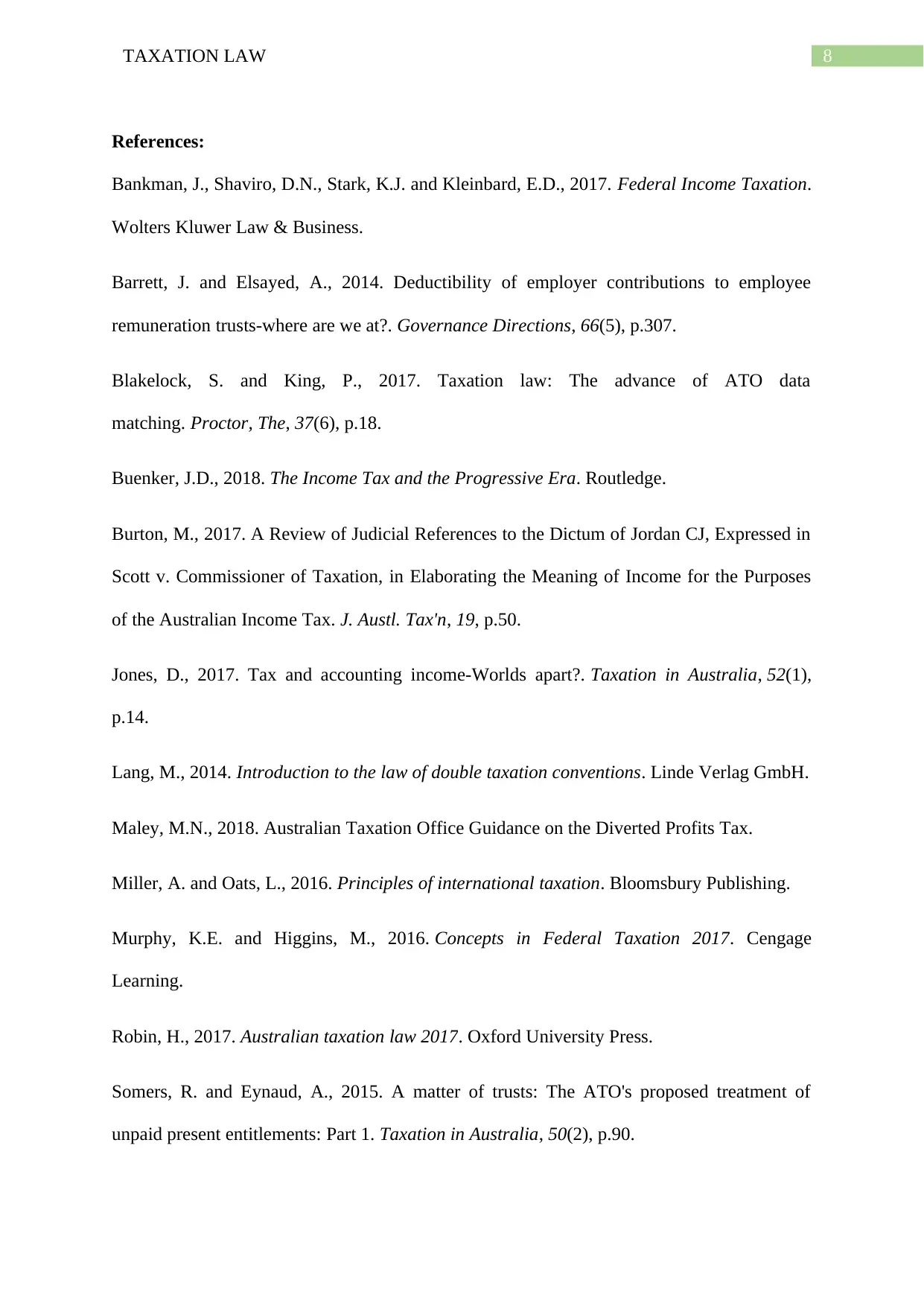
8TAXATION LAW
References:
Bankman, J., Shaviro, D.N., Stark, K.J. and Kleinbard, E.D., 2017. Federal Income Taxation.
Wolters Kluwer Law & Business.
Barrett, J. and Elsayed, A., 2014. Deductibility of employer contributions to employee
remuneration trusts-where are we at?. Governance Directions, 66(5), p.307.
Blakelock, S. and King, P., 2017. Taxation law: The advance of ATO data
matching. Proctor, The, 37(6), p.18.
Buenker, J.D., 2018. The Income Tax and the Progressive Era. Routledge.
Burton, M., 2017. A Review of Judicial References to the Dictum of Jordan CJ, Expressed in
Scott v. Commissioner of Taxation, in Elaborating the Meaning of Income for the Purposes
of the Australian Income Tax. J. Austl. Tax'n, 19, p.50.
Jones, D., 2017. Tax and accounting income-Worlds apart?. Taxation in Australia, 52(1),
p.14.
Lang, M., 2014. Introduction to the law of double taxation conventions. Linde Verlag GmbH.
Maley, M.N., 2018. Australian Taxation Office Guidance on the Diverted Profits Tax.
Miller, A. and Oats, L., 2016. Principles of international taxation. Bloomsbury Publishing.
Murphy, K.E. and Higgins, M., 2016. Concepts in Federal Taxation 2017. Cengage
Learning.
Robin, H., 2017. Australian taxation law 2017. Oxford University Press.
Somers, R. and Eynaud, A., 2015. A matter of trusts: The ATO's proposed treatment of
unpaid present entitlements: Part 1. Taxation in Australia, 50(2), p.90.
References:
Bankman, J., Shaviro, D.N., Stark, K.J. and Kleinbard, E.D., 2017. Federal Income Taxation.
Wolters Kluwer Law & Business.
Barrett, J. and Elsayed, A., 2014. Deductibility of employer contributions to employee
remuneration trusts-where are we at?. Governance Directions, 66(5), p.307.
Blakelock, S. and King, P., 2017. Taxation law: The advance of ATO data
matching. Proctor, The, 37(6), p.18.
Buenker, J.D., 2018. The Income Tax and the Progressive Era. Routledge.
Burton, M., 2017. A Review of Judicial References to the Dictum of Jordan CJ, Expressed in
Scott v. Commissioner of Taxation, in Elaborating the Meaning of Income for the Purposes
of the Australian Income Tax. J. Austl. Tax'n, 19, p.50.
Jones, D., 2017. Tax and accounting income-Worlds apart?. Taxation in Australia, 52(1),
p.14.
Lang, M., 2014. Introduction to the law of double taxation conventions. Linde Verlag GmbH.
Maley, M.N., 2018. Australian Taxation Office Guidance on the Diverted Profits Tax.
Miller, A. and Oats, L., 2016. Principles of international taxation. Bloomsbury Publishing.
Murphy, K.E. and Higgins, M., 2016. Concepts in Federal Taxation 2017. Cengage
Learning.
Robin, H., 2017. Australian taxation law 2017. Oxford University Press.
Somers, R. and Eynaud, A., 2015. A matter of trusts: The ATO's proposed treatment of
unpaid present entitlements: Part 1. Taxation in Australia, 50(2), p.90.
⊘ This is a preview!⊘
Do you want full access?
Subscribe today to unlock all pages.

Trusted by 1+ million students worldwide
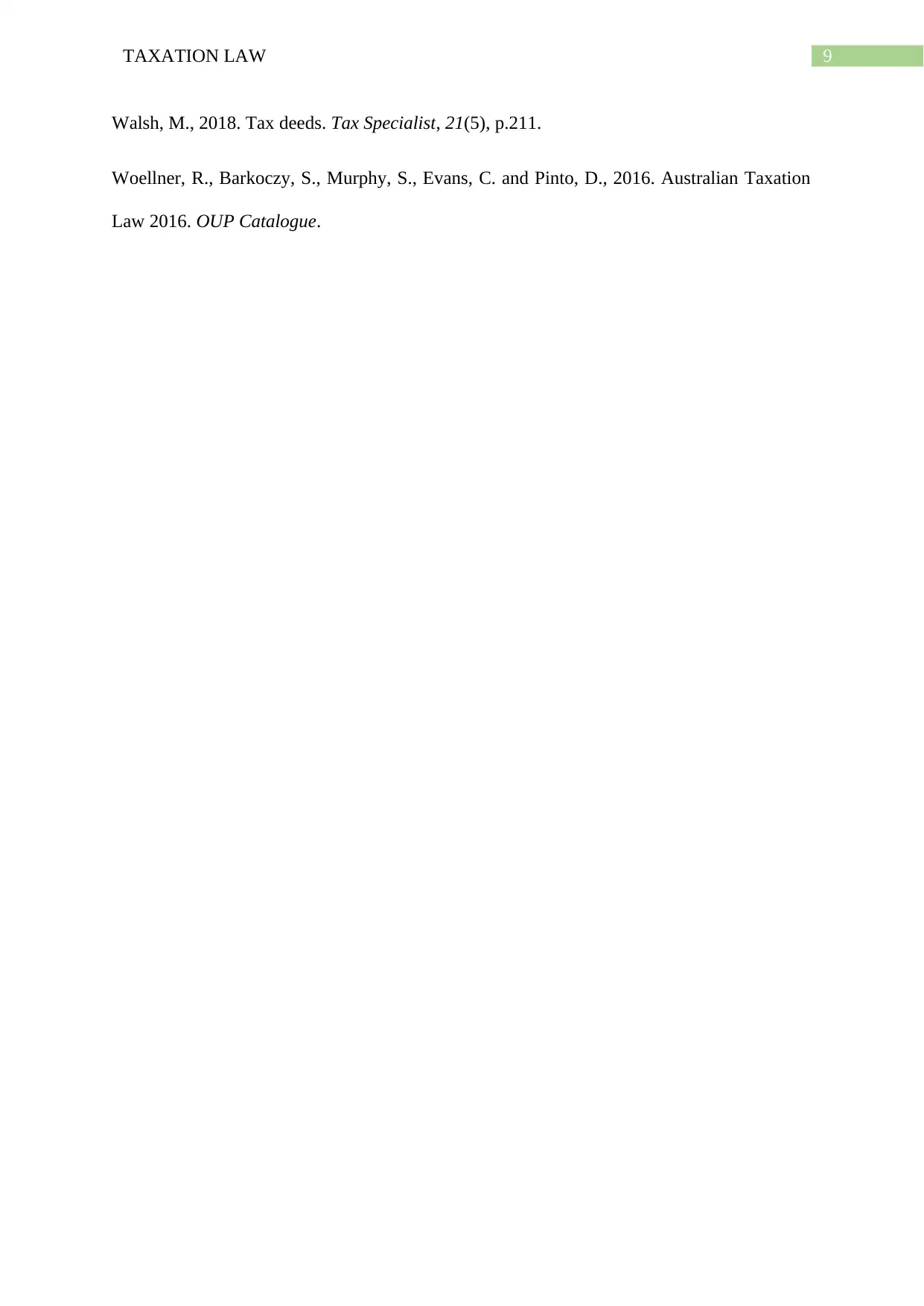
9TAXATION LAW
Walsh, M., 2018. Tax deeds. Tax Specialist, 21(5), p.211.
Woellner, R., Barkoczy, S., Murphy, S., Evans, C. and Pinto, D., 2016. Australian Taxation
Law 2016. OUP Catalogue.
Walsh, M., 2018. Tax deeds. Tax Specialist, 21(5), p.211.
Woellner, R., Barkoczy, S., Murphy, S., Evans, C. and Pinto, D., 2016. Australian Taxation
Law 2016. OUP Catalogue.
1 out of 10
Related Documents
Your All-in-One AI-Powered Toolkit for Academic Success.
+13062052269
info@desklib.com
Available 24*7 on WhatsApp / Email
![[object Object]](/_next/static/media/star-bottom.7253800d.svg)
Unlock your academic potential
Copyright © 2020–2025 A2Z Services. All Rights Reserved. Developed and managed by ZUCOL.




